|
|
The Holy Martyrs Hermylas and Stratonicus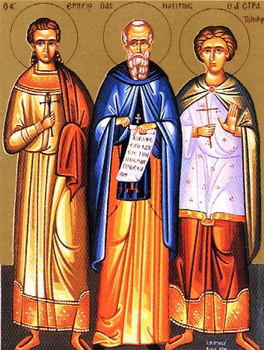 The Emperor Licinius launched a violent persecution against the Christians. St Hermylas, a Christian and a deacon in one of the churches, was arrested and condemned to death. When he was told that he was being taken out to martyrdom, he rejoiced greatly. The Emperor threatened him in vain; Hermylas openly confessed his faith in Christ and, in reply to the Emperor"s threats, said: "The Lord is my helper, I will not fear what man doeth unto me" (Ps. 117:6). After harsh torture, Hermylas was flung into prison. But the jailer was one Stratonicus, a secret Christian who was filled with whole-hearted compassion for Hermylas"s sufferings. When he too appeared before the Emperor as a Christian, Licinius ordered that they both be thrown into the Danube. So Hermylas and Stratonicus were bound together in one net and cast into the river. After three days the river threw their bodies onto the bank, and fellow-Christians took them and buried them a little way outside Belgrade. These glorious martyrs suffered for Christ and entered into glory in the year 315. The Emperor Licinius launched a violent persecution against the Christians. St Hermylas, a Christian and a deacon in one of the churches, was arrested and condemned to death. When he was told that he was being taken out to martyrdom, he rejoiced greatly. The Emperor threatened him in vain; Hermylas openly confessed his faith in Christ and, in reply to the Emperor"s threats, said: "The Lord is my helper, I will not fear what man doeth unto me" (Ps. 117:6). After harsh torture, Hermylas was flung into prison. But the jailer was one Stratonicus, a secret Christian who was filled with whole-hearted compassion for Hermylas"s sufferings. When he too appeared before the Emperor as a Christian, Licinius ordered that they both be thrown into the Danube. So Hermylas and Stratonicus were bound together in one net and cast into the river. After three days the river threw their bodies onto the bank, and fellow-Christians took them and buried them a little way outside Belgrade. These glorious martyrs suffered for Christ and entered into glory in the year 315.St James, Bishop of Nisibis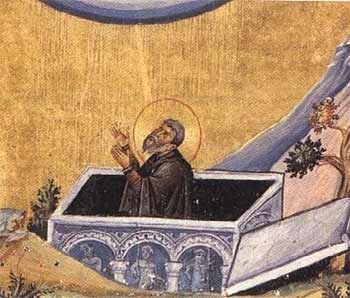 In summer in an open field and in winter in a cave, St James lived as a hermit. On one occasion he went down into the city of Nisibis in Mesopotamia, to look into the faith and life of the Christians, and was there elected by the people as their bishop. He took part in the First Ecumenical Council in 325 and defended Orthodoxy against the Arians.
It happened at one time that the pagan Persian army attacked Nisibis. St James went out onto the ramparts with the banner-icon from the church, himself raising it aloft and walking round the ramparts fearless of the arrows the enemy was aiming at him. Walking thus, the saint prayed to God to save the city and the faithful in it by sending flies and mosquitoes on the Persians, thus driving them away from the city walls. He did not, we see, seek the destruction of the enemy but some sort of catastrophe, no matter what, even some quite small occurrence, that would overcome them and remove them from the vicinity. God heard the prayer of His chosen one and sent a plague of flies and mosquitoes on the Persians, driving them away and saving the city of Nisibis. St James lived long and with honour, and died peacefully in great old age in the year 350. In summer in an open field and in winter in a cave, St James lived as a hermit. On one occasion he went down into the city of Nisibis in Mesopotamia, to look into the faith and life of the Christians, and was there elected by the people as their bishop. He took part in the First Ecumenical Council in 325 and defended Orthodoxy against the Arians.
It happened at one time that the pagan Persian army attacked Nisibis. St James went out onto the ramparts with the banner-icon from the church, himself raising it aloft and walking round the ramparts fearless of the arrows the enemy was aiming at him. Walking thus, the saint prayed to God to save the city and the faithful in it by sending flies and mosquitoes on the Persians, thus driving them away from the city walls. He did not, we see, seek the destruction of the enemy but some sort of catastrophe, no matter what, even some quite small occurrence, that would overcome them and remove them from the vicinity. God heard the prayer of His chosen one and sent a plague of flies and mosquitoes on the Persians, driving them away and saving the city of Nisibis. St James lived long and with honour, and died peacefully in great old age in the year 350.Our Holy Father Maximus of Kapsokalyvia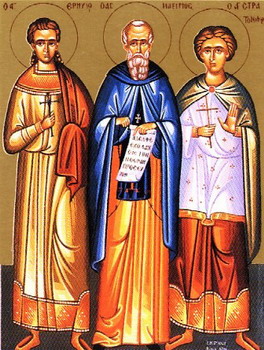 Maximus lived in the fourteenth century, following the ascetic life as a monk on the Holy Mountain according to his own particular way: that is to say, he pretended to be slightly crazed and constantly changed his abode. This being a hut of boughs, he built them and burned them down in rapid succession, thus earning himself the name 'of Kapsokalyvia', that is, 'of the burnt huts'. He was regarded as a fool until St Gregory the Sinaite came to the Holy Mountain and perceived in Maximus a unique ascetic, a wonderworker with the gift of prayer and an 'angel in the flesh'. He went to the Lord in the year 1320. Maximus lived in the fourteenth century, following the ascetic life as a monk on the Holy Mountain according to his own particular way: that is to say, he pretended to be slightly crazed and constantly changed his abode. This being a hut of boughs, he built them and burned them down in rapid succession, thus earning himself the name 'of Kapsokalyvia', that is, 'of the burnt huts'. He was regarded as a fool until St Gregory the Sinaite came to the Holy Mountain and perceived in Maximus a unique ascetic, a wonderworker with the gift of prayer and an 'angel in the flesh'. He went to the Lord in the year 1320.Martyr Peter of Anium, at EleutheropolisPeter Abselamus (also known as Peter Absalon, Peter Balsamus, and Peter of Atroa), also called, "the Standard Bearer", was a third-century Christian martyr. He was born in Anea, near Eleutheropolis and was known for his physical strength, charity and piety.
There is substantial disagreement regarding his death in 311 AD. The account in his Acta Sanctorum indicate that he was tortured and killed at Aulana, near Hebron, and later crucified. Another account, in Eusebius of Caesarea's History of the Martyrs in Palestine, indicates he was burned alive in Caesarea. While another account gives a date of the 11th of Jan 309.
Louis-Sébastien Le Nain de Tillemont has stated that two different people are mentioned in the accounts. He stated that Peter Abselamus was crucified at Aulana, and that a different person, Peter Absalon, was burned at Caesarea.
The martyr at Aulana is commemorated as a saint, with a feast day of January 3. The martyr at Caesarea's feast day is January 13. The Greek liturgy has his feast day on Oct 14. and is the only Palestinian martyrs from the persecution of Diocletian, who has his name in the Jerusalem calendar.
Martyr Athanasius
Venerable Irenarchus the Recluse of Rostov (1616)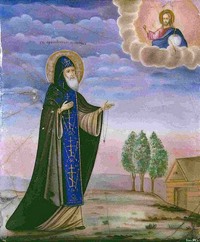 Irenarchus, Hermit of Rostov, was born into a peasant family in the village of Kondakovo in the Rostov district. In Baptism he received the name Elias. In his thirtieth year, he was tonsured a monk at the Rostov Sts Boris and Gleb monastery. There he began fervently to labor at monastic tasks, he attended church services, and by night he prayed and slept on the ground. Once, taking pity on a vagrant who did not have shoes, St Irenarchus gave him his own boots, and from that time he began to go barefoot through the snow.
The igumen did not care for such behavior, and he began to humiliate him, compelling him to stand for an hour or nearly two in the snow opposite his cell, or to ring the bells for a long time. The saint endured everything with patience but he did not change his conduct. The igumen continued to be hard-hearted, and the monk was obliged to transfer to the Abramiev Theophany monastery, where he was accepted into the number of the brethren and he was soon chosen as steward.
The saint fulfilled his monastic obediences with zeal, but grieved that the brethren and servants did not look after the property of the monastery, but imprudently wasted it. Once in a dream he saw St Abraham of Rostov (October 29), who comforted him and blessed him to distribute necessities to all without trouble. Later, St Irenarchus sobbed loudly during the singing of the Cherubimic hymn. The archimandrite asked him why he wept, and he answered, “My mother has died!”
Leaving Abramiev monastery, St Irenarchus transferred to the Rostov monastery of St Lazarus, settled into a solitary cell and lived for three years in privation and hunger. Here he was visited by Blessed John the Fool, nicknamed “the Big Simpleton.” The saints encouraged each other by spiritual conversation. The Elder, however, had a desire to return to the Sts Boris and Gleb monastery. He was accepted back with love by the strict Barlaam, and he began to pursue even greater ascetic deeds at the monastery.
Having withdrawn into solitude, St Irenarchus chained himself to a wooden chair, and he placed on himself heavy chains and crosses. For this he endured the mockery and sneers of the brethren. During this time he was visited by his old friend, Blessed John the Fool, who predicted the Lithuanian invasion of Moscow.
St Irenarchus spent twenty-five years shackled in chains and in arduous tasks. His ascetic deeds were a silent reproach to those living carelessly at the monastery, and they lied to the igumen about him. They said that the Elder taught that they should not do monastic work, but rather pursue asceticism as he did. The igumen believed the slander and he banished the holy Elder from the monastery. Humbly submitting, St Irenarchus again went to Rostov and lived in the monastery of St Lazarus for one year.
Meanwhile the igumen of Sts Boris and Gleb regretted his conduct and sent monks after St Irenarchus. He returned, blaming himself that he did not live like the brethren who engaged in righteous works, in which he was lacking. The monk continued to bear his own heavy fetters. He made clothes for the needy, and he knitted hairshirts and klobuks. He slept at night for only an hour or two, the rest of the time he prayed and beat his body with an iron rod.
St Irenarchus had a vision that Lithuania would invade Moscow, and that churches there would be destroyed. He began to weep bitterly about the impending disaster, and the igumen ordered him to go to Moscow and warn Tsar Basil Shuisky (1606-1610) about the terrible misfortune. St Irenarchus carried out the order. He refused the gifts offered him and when he returned, he began to pray fervently that the Lord would show mercy on the Russian land.
Enemies appeared against Russia, they began the conquest of the city, beat the inhabitants, and robbed churches and monasteries. The False Demetrius and a second Pretender sought to conquer Russia for the Polish king. Sts Boris and Gleb monastery was also overrun by the enemy, who came to the holy hermit and were amazed at the direct and bold words of the Elder, predicting catastrophe for them.
Sapega, remaining at the Sts Boris and Gleb monastery, wanted to see the Elder sitting in chains, and he was amazed at such an ascetic exploit. When the Polish nobles with Sapega told him that the Elder prayed for Shuisky, the monk boldly said, “I am born and baptized in Russia, and I pray to God for the Russian Tsar.” Sapega answered, “Grandfather speaks truly; in whatever land one lives, there one also serves.” After this St Irenarchus began to urge Sapega to leave Russia, predicting death for him if he did not do so.
St Irenarchus followed the course of the war and sent his blessings and a prosphora to Prince Demetrius Pozharsky. He told him to come to Moscow, predicting, “You shall see the glory of God.” To assist Pozharsky and Minin, the saint handed over his cross. With the help of God the Russians vanquished the Lithuanians, Prince Pozharsky took possession of the Kremlin, and peace gradually began to return to the Russian land. St Irenarchus incessantly prayed God with tears for the deliverance of Russia from enemies and, with the power to work miracles, he healed the sick and demoniacs.
The day of his death was revealed to him, and summoning his disciples Alexander and Cornelius, he gave them his final instructions. After taking leave of all he quietly fell asleep in the Lord. The holy Elder left behind 142 copper crosses, seven shoulder chains, other chains which he wore on his neck, iron foot shackles, eighteen hand fetters, heavy “bonds” which he wore on his belt, and iron rods with which he thrashed his body to drive away demons.
In these works, as the Elder called them, he spent thirty-eight years, and having lived in the world for thirty years, he died in his sixty-eighth year. After the death of St Irenarchus, many miracles took place at his grave, especially the healing of the sick and the demoniacs by laying the holy ascetic’s crosses and chains upon them. Irenarchus, Hermit of Rostov, was born into a peasant family in the village of Kondakovo in the Rostov district. In Baptism he received the name Elias. In his thirtieth year, he was tonsured a monk at the Rostov Sts Boris and Gleb monastery. There he began fervently to labor at monastic tasks, he attended church services, and by night he prayed and slept on the ground. Once, taking pity on a vagrant who did not have shoes, St Irenarchus gave him his own boots, and from that time he began to go barefoot through the snow.
The igumen did not care for such behavior, and he began to humiliate him, compelling him to stand for an hour or nearly two in the snow opposite his cell, or to ring the bells for a long time. The saint endured everything with patience but he did not change his conduct. The igumen continued to be hard-hearted, and the monk was obliged to transfer to the Abramiev Theophany monastery, where he was accepted into the number of the brethren and he was soon chosen as steward.
The saint fulfilled his monastic obediences with zeal, but grieved that the brethren and servants did not look after the property of the monastery, but imprudently wasted it. Once in a dream he saw St Abraham of Rostov (October 29), who comforted him and blessed him to distribute necessities to all without trouble. Later, St Irenarchus sobbed loudly during the singing of the Cherubimic hymn. The archimandrite asked him why he wept, and he answered, “My mother has died!”
Leaving Abramiev monastery, St Irenarchus transferred to the Rostov monastery of St Lazarus, settled into a solitary cell and lived for three years in privation and hunger. Here he was visited by Blessed John the Fool, nicknamed “the Big Simpleton.” The saints encouraged each other by spiritual conversation. The Elder, however, had a desire to return to the Sts Boris and Gleb monastery. He was accepted back with love by the strict Barlaam, and he began to pursue even greater ascetic deeds at the monastery.
Having withdrawn into solitude, St Irenarchus chained himself to a wooden chair, and he placed on himself heavy chains and crosses. For this he endured the mockery and sneers of the brethren. During this time he was visited by his old friend, Blessed John the Fool, who predicted the Lithuanian invasion of Moscow.
St Irenarchus spent twenty-five years shackled in chains and in arduous tasks. His ascetic deeds were a silent reproach to those living carelessly at the monastery, and they lied to the igumen about him. They said that the Elder taught that they should not do monastic work, but rather pursue asceticism as he did. The igumen believed the slander and he banished the holy Elder from the monastery. Humbly submitting, St Irenarchus again went to Rostov and lived in the monastery of St Lazarus for one year.
Meanwhile the igumen of Sts Boris and Gleb regretted his conduct and sent monks after St Irenarchus. He returned, blaming himself that he did not live like the brethren who engaged in righteous works, in which he was lacking. The monk continued to bear his own heavy fetters. He made clothes for the needy, and he knitted hairshirts and klobuks. He slept at night for only an hour or two, the rest of the time he prayed and beat his body with an iron rod.
St Irenarchus had a vision that Lithuania would invade Moscow, and that churches there would be destroyed. He began to weep bitterly about the impending disaster, and the igumen ordered him to go to Moscow and warn Tsar Basil Shuisky (1606-1610) about the terrible misfortune. St Irenarchus carried out the order. He refused the gifts offered him and when he returned, he began to pray fervently that the Lord would show mercy on the Russian land.
Enemies appeared against Russia, they began the conquest of the city, beat the inhabitants, and robbed churches and monasteries. The False Demetrius and a second Pretender sought to conquer Russia for the Polish king. Sts Boris and Gleb monastery was also overrun by the enemy, who came to the holy hermit and were amazed at the direct and bold words of the Elder, predicting catastrophe for them.
Sapega, remaining at the Sts Boris and Gleb monastery, wanted to see the Elder sitting in chains, and he was amazed at such an ascetic exploit. When the Polish nobles with Sapega told him that the Elder prayed for Shuisky, the monk boldly said, “I am born and baptized in Russia, and I pray to God for the Russian Tsar.” Sapega answered, “Grandfather speaks truly; in whatever land one lives, there one also serves.” After this St Irenarchus began to urge Sapega to leave Russia, predicting death for him if he did not do so.
St Irenarchus followed the course of the war and sent his blessings and a prosphora to Prince Demetrius Pozharsky. He told him to come to Moscow, predicting, “You shall see the glory of God.” To assist Pozharsky and Minin, the saint handed over his cross. With the help of God the Russians vanquished the Lithuanians, Prince Pozharsky took possession of the Kremlin, and peace gradually began to return to the Russian land. St Irenarchus incessantly prayed God with tears for the deliverance of Russia from enemies and, with the power to work miracles, he healed the sick and demoniacs.
The day of his death was revealed to him, and summoning his disciples Alexander and Cornelius, he gave them his final instructions. After taking leave of all he quietly fell asleep in the Lord. The holy Elder left behind 142 copper crosses, seven shoulder chains, other chains which he wore on his neck, iron foot shackles, eighteen hand fetters, heavy “bonds” which he wore on his belt, and iron rods with which he thrashed his body to drive away demons.
In these works, as the Elder called them, he spent thirty-eight years, and having lived in the world for thirty years, he died in his sixty-eighth year. After the death of St Irenarchus, many miracles took place at his grave, especially the healing of the sick and the demoniacs by laying the holy ascetic’s crosses and chains upon them. Martyrs Pachomius and PapyrinusMartyrs by drowning
Venerable Eleazar of Anzersk Island at Solovki (1656)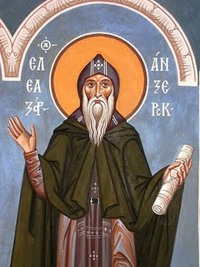 Saint Eleazar of Anzersk was born in the city of Kozelsk into the merchant family Severiukov. With the blessing of his parents he went off to the Solovki monastery, where he received monastic tonsure from the igumen St Irenarchus (July 17).
At the monastery he displayed an astonishing artistic gift: he learned woodcarving and he took part in the embellishment of the Transfiguration cathedral. With the blessing of the igumen, he went to the island of Anzersk in 1612, where he became a hermit, devoting himself to constant prayer and meditation on God.
In order to obtain subsistence for himself on the island wilderness, St Eleazar carved wooden cups, which he left at the dock. On the cups he wrote a message requesting food. Fishermen left bread and other supplies for the ascetic, and they were rewarded with a great catch of fish.
In the year 1616 St Eleazar was elevated to schemamonk. Disciples gathered around the saint wishing to live near him and benefit from his instruction. He organized a skete with a strict rule of monastic life following the ancient form. Monastic cells were built far away from one another, and the hermits gathered together only for Saturday and Sunday services.
Among the disciples of St Eleazar was the hieromonk Nikita, the future Patriarch Nikon. Tsar Michael (1613-1645), learning of the saint’s ascetic life, summoned him to Moscow. St Eleazar predicted the birth of a son, and in return the Tsar generously gave him help to build a stone church on the island dedicated to the Holy Trinity, and also a monastery.
St Eleazar loved books. He compiled three books, “Flower gardens,” collecting edifying sayings and examples from various sources. He also wrote a commentary on the Rule for monastic cell life.
St Eleazar died in great old age, forseeing the time of his death. It is not known how old he was, but he lived at Ansersk for forty years, and he was at Solovki for some time before that. Saint Eleazar of Anzersk was born in the city of Kozelsk into the merchant family Severiukov. With the blessing of his parents he went off to the Solovki monastery, where he received monastic tonsure from the igumen St Irenarchus (July 17).
At the monastery he displayed an astonishing artistic gift: he learned woodcarving and he took part in the embellishment of the Transfiguration cathedral. With the blessing of the igumen, he went to the island of Anzersk in 1612, where he became a hermit, devoting himself to constant prayer and meditation on God.
In order to obtain subsistence for himself on the island wilderness, St Eleazar carved wooden cups, which he left at the dock. On the cups he wrote a message requesting food. Fishermen left bread and other supplies for the ascetic, and they were rewarded with a great catch of fish.
In the year 1616 St Eleazar was elevated to schemamonk. Disciples gathered around the saint wishing to live near him and benefit from his instruction. He organized a skete with a strict rule of monastic life following the ancient form. Monastic cells were built far away from one another, and the hermits gathered together only for Saturday and Sunday services.
Among the disciples of St Eleazar was the hieromonk Nikita, the future Patriarch Nikon. Tsar Michael (1613-1645), learning of the saint’s ascetic life, summoned him to Moscow. St Eleazar predicted the birth of a son, and in return the Tsar generously gave him help to build a stone church on the island dedicated to the Holy Trinity, and also a monastery.
St Eleazar loved books. He compiled three books, “Flower gardens,” collecting edifying sayings and examples from various sources. He also wrote a commentary on the Rule for monastic cell life.
St Eleazar died in great old age, forseeing the time of his death. It is not known how old he was, but he lived at Ansersk for forty years, and he was at Solovki for some time before that. |